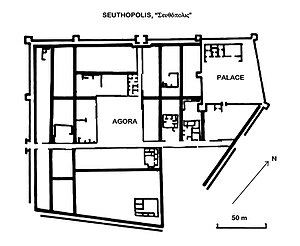Seuthopolis
Seuthopolis ( Bulgarian Севтополис , ancient Greek Σευθόπολις , city of Seuthes' ) was the royal seat of the Thracian king Seuthes III. Seuthopolis is located about 5 km west of the city of Kazanlak in Bulgaria .
history
Seuthopolis was about three kilometers south of today's Koprinka , near Kazanlak at the mouth of the Golyama Varowiza River in the Tundscha . According to the excavators, the city was founded in the late 4th century BC. Built by the Thracians on the model of the Greek Poleis and existed until the 260s BC. The pentagonal urban area of Seuthopolis was enclosed by an 890 m long city wall and covered five hectares . At the Agora , a was Dionysus temple an altar in the Agora. In the northern part of Seuthopolis, surrounded by its own wall, there was a fortified complex, probably the residence of Seuthes III.
Judging by the numerous amphorae temples that had been found, the city had extensive trade relations, and the craft (pottery and metalworking) was well developed. The city minted its own coins.
The ruins of the city were discovered in 1948 during the construction work on the Georgi Dimitrov Dam (today Koprinka Reservoir ) and explored until its completion. Despite the sensational find, the dam, which was a prestige project of the Bulgarian communists, was completed and the ruins were flooded. To emphasize its independence from Greece, the city became the capital of the Odrysians and the only city that was not built on Greek initiative, but by Greek craftsmen on behalf of Odrysian elites. This interpretation is now considered to be an expression of "nationalism, romanticism and the glorification of the Thracian past in Bulgarian archeology".
In autumn 2008 a plan was published to dry up the ruins of the city by means of a concrete ring built around them and thus make them accessible again to archaeologists and visitors. This plan has not yet been implemented.
Since 2005, the city has given its name to Sevtopolis Peak on Greenwich Island in Antarctica.
literature
- Iris von Bredow : Seuthopolis. In: The New Pauly (DNP). Volume 11, Metzler, Stuttgart 2001, ISBN 3-476-01481-9 , column 482 f.
- Dimitur P. Dimitrov: Sevtopolis, 1. Bit i kultura. [Seuthopolis, 1. Life and Culture]. Izdatelstvo na Bălgarskata akademija na naukite, Sofia 1984.
- Dimitur P. Dimitrov: Sevtopolis, 2. Antični i srednovekovni moneti. [Seuthopolis, 2. Ancient and Medieval Coins]. Izdatelstvo na Bălgarskata akademija na naukite, Sofia 1984.
- Dimitur P. Dimitrov, Maria Cicikova: The Thracian city of Seuthopolis. (British archaeological reports. Supplementary series 38). British Archaeological Reports, Oxford, 1978. ISBN 0-86054-003-0 .
- Antonio Frova : Seuthopolis Kazanlak, S. Bulgaria . In: Richard Stillwell et al. a. (Ed.): The Princeton Encyclopedia of Classical Sites. Princeton University Press, Princeton NJ 1976, ISBN 0-691-03542-3 .
- Ronald Sprafke: Lifebuoy for Seuthopolis. In: Bild der Wissenschaft issue 06/2009, pp. 88–89 ( full text ).
- Stephan Lehmann : Seuthopolis. The Hellenized ruler Seuthes III. (approx. 330–295 BC) and his royal seat in the Bulgarian Rosental , in: R. Fikentscher (Ed.), Wohnkulturen in Europa (Halle 2016), 36–48.
Web links
- Project page
- Seutopolis project and archaeological projection
- Thracian city rescued from reservoir - Article in Welt online from February 24, 2009
Individual evidence
- ↑ Ivan Vranić: 'Hellenisation' and Ethnicity in the Continental Balkan Iron Age, in: Cătălin Nicolae Popa, Simon Stoddart (ed.): Fingerprinting the Iron Age. Approaches to identity in the European Iron Age: Integrating South-Eastern Europe into the Debate , Oxbow Books, 2014, pp. 161–172, here: p. 166.
- ↑ Bulgaria's new landmark. In: orf.at. October 20, 2008, accessed October 20, 2008 .
Coordinates: 42 ° 37 ′ 5 ″ N , 25 ° 18 ′ 20 ″ E
